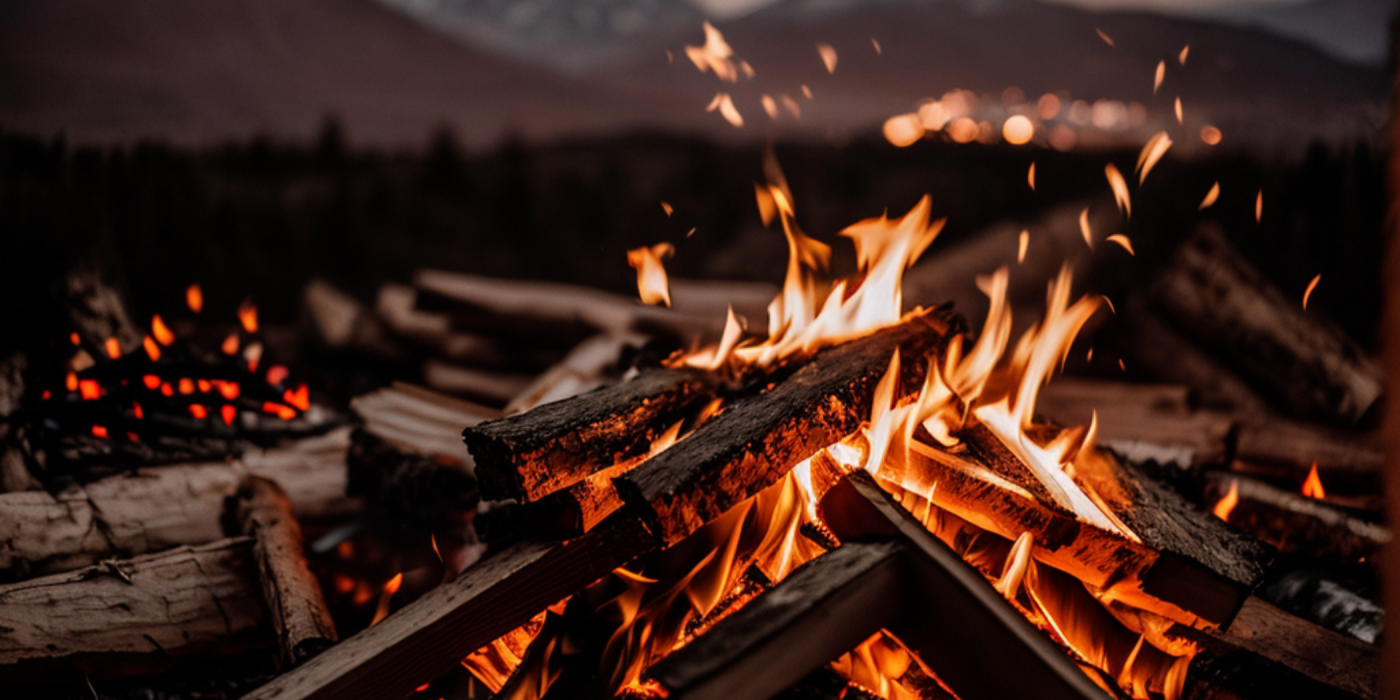Everything You Need to Know About Burning Wood in a Fire Pit

There's a certain magic to gathering around a fire pit, whether it's to enjoy a starry summer night, roast marshmallows with the kids, or simply escape from the chilly breeze during cooler months. The warmth of the flames, the crackle of the burning wood, and the dance of the embers all contribute to a mesmerising and comforting outdoor experience.
The Role of Wood Burning
Yet, behind this captivating spectacle lies a vital element - wood. The quality of your fire pit experience largely depends on how you burn your wood. A proper burn provides a consistent flame, generates sufficient heat, minimises smoke, and contributes to the longevity of your fire pit. Burning wood properly isn't just about creating a good fire, it's also a matter of safety and environmental responsibility.
Objective of the Article
In this article, we aim to be your comprehensive guide to burning wood in a fire pit. We will delve into the science of wood burning, discuss how to choose and prepare your wood, demonstrate how to build a fire, and address important safety considerations. Further, we will explore the environmental impact of burning wood and provide tips on how to minimise it.
Whether you're a seasoned fire pit enthusiast or a beginner, this guide will equip you with the knowledge you need for an excellent, eco-friendly, and safe fire pit experience. So, let's embark on this journey to harness the true potential of your fire pit through the art of wood burning.
Understanding the Science of Wood Burning
How Wood Burns
The process of burning wood, also known as combustion, is a chemical reaction that transforms wood into heat, light, water vapour, and gases. This process begins when the wood is heated to its ignition point, roughly around 300 degrees Celsius. At this point, the wood starts to decompose and release volatile gases.
These gases mix with oxygen in the air and, when they reach a certain temperature, they ignite to produce flames. The actual wood doesn't burn directly until most of the volatile gases are released. What's left behind after the gases have burned off is charcoal, which then burns directly to create the glowing embers and heat.
The Pyrolysis Stage
This initial stage of burning, where the wood is heated and volatile gases are released, is called pyrolysis. Understanding pyrolysis is key to understanding why certain types of wood, particularly seasoned wood, burn more efficiently and produce less smoke.
The Science Behind Efficient Wood Burning
The efficiency of wood burning hinges largely on moisture content. Wood with high moisture content requires more energy to burn because the energy is used first to evaporate the moisture before the wood can begin to undergo pyrolysis.
Dry, seasoned wood, on the other hand, has a low moisture content and burns more efficiently, as the energy from the fire can immediately go into creating heat and light. This results in a hotter, cleaner burn with less smoke - ideal for a comfortable and enjoyable fire pit experience.
Choosing the Right Wood
The Importance of Proper Wood Selection
When it comes to enjoying a fire pit, the type of wood you use can make all the difference. Selecting the right wood will not only ensure a longer and more controlled burn but also reduce the amount of smoke produced and improve the overall aroma. Making the correct choice can be the difference between a pleasant, relaxing evening and one marred by excessive smoke and constant fire maintenance.
Hardwoods Vs Softwoods
The wood you choose can be broadly classified into two categories: hardwoods and softwoods. Hardwoods, such as oak, ash, or birch, are denser and heavier. This density translates into a longer, hotter burn, making them an ideal choice for fire pits. They also tend to produce less smoke and a pleasant aroma when burned.
On the other hand, softwoods like pine or spruce, while easier to ignite, burn faster and produce more smoke. They're suitable for kindling but not ideal for sustaining a fire over a long period.
The Preference for Dry, Seasoned Wood
Regardless of whether you choose a hardwood or softwood, it's important that the wood is dry and seasoned. Seasoned wood refers to wood that has been cut and dried for at least 6-12 months. This drying process reduces the moisture content in the wood, allowing it to burn more efficiently and produce less smoke.
In contrast, fresh or 'green' wood has a high moisture content that creates a lot of smoke when burned. Hence, always opt for dry, seasoned wood for a superior fire pit experience.
Preparing Your Wood for Burning
The Process of Seasoning Wood
Seasoning is the process of allowing wood to dry naturally over a period of time, often six months to a year, or even more depending on the type and size of the wood. When freshly cut, wood contains a high amount of moisture which makes it hard to burn and leads to more smoke when it does.
To season your wood, start by chopping it into the right size for your fire pit. Then stack it in a dry, breezy area where it can get plenty of sunlight. The wood should be stacked off the ground to prevent it from absorbing moisture. It's also advisable to stack it in such a way that air can circulate freely between the logs.
Seasoning Time
Different types of wood require different seasoning times. Hardwoods, for instance, generally take longer to season than softwoods due to their denser nature. It's a good idea to plan ahead and start the seasoning process well before you'll need the wood.
Proper Storage and Covering of Firewood
Proper storage of your seasoned wood is crucial to maintaining its quality. Wood should always be stored in a dry place to prevent it from getting damp and mouldy.
A good storage solution is a woodshed or a sheltered area where the wood can stay dry but still have airflow to prevent mould growth. Covering the top of your wood pile with a waterproof cover can protect it from rain or snow, but remember to keep the sides exposed for ventilation.
Importance of Covering
While it might be tempting to entirely cover your firewood to protect it from the elements, doing so can restrict airflow and promote the growth of mould. It's a balance between keeping your wood dry and allowing it to breathe.
By properly seasoning and storing your wood, you'll ensure a higher quality burn with less smoke and a more enjoyable fire pit experience.
How to Build a Fire with Wood
Step-by-Step Guide to Building a Fire
Building a fire in your fire pit requires proper technique to ensure a successful and enjoyable experience. Follow these steps for effective wood burning:
-
Prepare the Fire Pit: Clear any debris or flammable materials around the fire pit to create a safe area for your fire.
-
Choose the Right Wood: Select dry, seasoned wood for optimal burning. Avoid using green or wet wood, as it can produce excessive smoke and hinder the fire's performance.
-
Arrange the Wood: Begin by placing larger logs or pieces of wood at the bottom of the fire pit. Lay them parallel to each other, leaving small gaps between them to allow for airflow.
-
Add Smaller Logs: On top of the base layer, add smaller logs or pieces of wood, crisscrossing them to create a stable structure. This layer helps with proper airflow and encourages better combustion.
-
Kindling and Fire Starters: Place a layer of kindling, such as small dry twigs or newspaper, on top of the smaller logs. You can also use fire starters for convenience and quicker ignition.
-
Ignite the Fire: Light the kindling or fire starters using matches or a lighter. Ensure that the flames catch and spread evenly.
-
Maintain Airflow: As the fire grows, keep an eye on the airflow. Avoid overcrowding the fire pit with too much wood, as it can restrict airflow and result in a smoky fire.
The Top-Down Fire-Building Method
One effective technique for building a fire is the top-down method. This approach ensures a longer-lasting and more consistent fire. Follow these steps:
-
Place the largest logs or pieces of wood at the bottom of the fire pit.
-
Layer smaller logs or pieces of wood on top, perpendicular to the base logs.
-
Continue layering smaller logs, gradually reducing the size as you move up.
-
Add kindling and fire starters at the very top.
-
Ignite the fire at the top, allowing it to slowly burn down through the layers of wood.
The top-down method promotes efficient combustion, as the fire gradually ignites the wood below, resulting in a longer-lasting fire with reduced smoke production.
Remember to always exercise caution when building and maintaining a fire. Keep a safe distance from the flames, have a fire extinguisher or water source nearby, and follow any local fire regulations and safety guidelines. Enjoy the warmth and beauty of your wood-burning fire pit responsibly!
Safety Considerations When Burning Wood
Importance of a Safety-First Approach
Burning wood in a fire pit can provide warmth and create a cozy atmosphere, but it is crucial to prioritize safety. By following proper guidelines and taking necessary precautions, you can ensure a safe and enjoyable fire pit experience for yourself and those around you.
Fire Pit Location and Clearances
Selecting an appropriate location for your fire pit is paramount. It should be placed on a non-combustible surface, away from overhanging branches, buildings, and flammable materials. Ensure that there is sufficient clearance around the fire pit to prevent accidental fires and allow for proper ventilation.
Proper Fire Pit Setup
When setting up your fire pit, carefully read and follow the manufacturer's instructions. Ensure that the fire pit is stable and placed on a level surface to prevent tipping. Use fire-resistant materials to create a safe fire pit area, such as rocks or bricks, to help contain the fire and prevent it from spreading.
Guidelines for a Safe Fire Pit Experience
Fire Safety Equipment
Keep essential fire safety equipment readily available near the fire pit. This should include a fire extinguisher, a bucket of water, or a hose to quickly extinguish any unwanted flames. Familiarize yourself with how to use these tools effectively.
Supervision and Attentiveness
Never leave a burning fire pit unattended. Fires can quickly escalate, and it is essential to have someone responsible supervising the fire at all times. Ensure that children and pets are supervised and kept at a safe distance from the fire pit.
Extinguishing the Fire Properly
When you are finished using the fire pit, make sure to fully extinguish the fire. Use water or sand to douse the flames, and carefully stir the ashes to ensure there are no remaining embers. Allow the fire pit to cool completely before leaving the area.
Conclusion
Prioritizing safety when burning wood in a fire pit is crucial for a worry-free and enjoyable experience. By adhering to proper guidelines, ensuring fire safety equipment is readily available, and practicing attentiveness, you can create a safe environment for everyone involved. Remember, responsible fire pit usage contributes to a positive and accident-free outdoor gathering.
Environmental Impact of Wood Burning
Understanding the Environmental Implications
Burning wood in a fire pit can have both positive and negative environmental impacts. While wood is a renewable resource and burning it can be carbon-neutral, there are important considerations to keep in mind.
Carbon Emissions and Air Quality
When wood is burned, carbon dioxide (CO2) is released into the atmosphere. While trees absorb CO2 during their growth, the immediate release of this greenhouse gas contributes to climate change. Additionally, incomplete combustion can release harmful pollutants, such as carbon monoxide (CO) and particulate matter (PM), which can degrade air quality.
Minimizing the Environmental Impact
Despite these concerns, there are measures you can take to minimize the environmental impact of wood burning in a fire pit.
Choose Sustainable and Local Wood Sources
Opt for sustainably sourced firewood from certified suppliers or consider using wood from pruning, fallen branches, or local tree removals. By choosing local sources, you reduce the carbon footprint associated with transportation.
Use Dry, Seasoned Wood
Burning dry, seasoned wood improves combustion efficiency and reduces emissions. Properly seasoned wood has lower moisture content, leading to cleaner and more efficient burning.
Avoid Burning Treated or Painted Wood
Treated or painted wood often contains chemicals that, when burned, release harmful pollutants into the air. Avoid using such wood in your fire pit to minimize environmental impact.
Practice Proper Fire-Building Techniques
Using proper fire-building techniques, such as the top-down method, ensures more complete combustion, reducing emissions and improving air quality. Properly arranging the wood allows for optimal airflow and more efficient burning.
Maintain and Clean Your Fire Pit Regularly
Regular maintenance and cleaning of your fire pit help optimize combustion and reduce the production of harmful pollutants. Remove ash and debris, as a clean fire pit promotes better airflow and reduces the risk of smoldering or inefficient burning.
Conclusion
In conclusion, while wood burning in a fire pit has environmental implications, adopting responsible practices can mitigate the impact. Choose sustainably sourced, dry, seasoned wood, practice proper fire-building techniques, and maintain your fire pit regularly. By doing so, you can enjoy the warmth and ambience of your fire pit while minimizing the environmental footprint of wood burning.
Recap of Key Points
In this comprehensive guide, we have explored everything you need to know about burning wood in a fire pit. Let's recap the key points covered to ensure a successful and enjoyable fire pit experience.
The Science of Wood Burning
Understanding the science behind wood burning is crucial for achieving efficient and long-lasting fires. By comprehending how wood burns and the factors that influence combustion, you can optimize your fire pit experience.
Choosing the Right Wood
Selecting the appropriate wood is essential for a successful fire pit session. Hardwoods, such as oak or maple, are preferred over softwoods due to their higher density and longer burn times. Additionally, using dry, seasoned wood is vital to ensure efficient burning and reduce smoke production.
Proper Wood Preparation
Preparing your wood properly plays a significant role in achieving optimal burning conditions. Seasoning wood by allowing it to dry thoroughly is essential to reduce moisture content. Storing and covering firewood appropriately also prevents exposure to the elements, ensuring it remains dry and ready for use.
Building a Fire with Wood
Mastering the art of fire-building is essential for a successful fire pit experience. The step-by-step guide provided will help you build a fire using wood, including the highly effective top-down fire-building method.
Benefits of Correctly Burning Wood
When wood is burned correctly in a fire pit, it offers a range of benefits. You can enjoy the warmth, comfort, and mesmerizing beauty of a crackling fire while creating a cozy ambiance for gatherings and relaxation. Properly burned wood also minimizes smoke production, ensuring a more pleasant experience for you and your guests.
Encouraging Responsible and Eco-Friendly Practices
As fire pit enthusiasts, it is our responsibility to practice safe and eco-friendly habits. By adhering to fire safety guidelines and minimizing our environmental impact, we can enjoy the pleasures of outdoor fires while preserving nature for future generations. Embrace responsible practices such as using sustainable firewood sources and minimizing smoke emissions.
By following the guidelines and insights provided in this article, you can enhance your fire pit experience, promote fire safety, and contribute to a healthier environment.
Remember to share this valuable guide with fellow fire pit enthusiasts and keep the flame of knowledge burning bright.
Related to this article are the following:
I do hope you have enjoyed this article and hope that you will subscribe to my newsletter so you can get the latest information about all things naturally relaxing.
Stay in touch, join the Naturally Relaxing Newsletter
Newsletter Signup
Post Your Comments
or post as a guest
Be the first to comment.
Latest articles in Relaxation

Capturing the Perfect Sunset: Tips and Techniques

The Benefits of Aromatherapy: Essential Oils for Relaxation

Embracing Calm: Innovative Ways to Relax in the New Year

Autumn Aromatherapy: Essential Oils for Relaxation

Embracing Autumn's Tranquillity: Finding Peace in the UK's Golden Season






